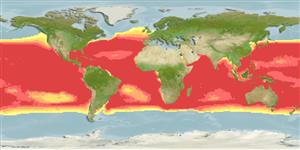Classification / Names
Common names from other countries
Main reference
Size / Weight / Age
Max length : 239 cm FL male/unsexed; (Ref. 40637); common length : 150 cm FL male/unsexed; (Ref. 168); max. published weight: 200.0 kg (Ref. 26550); max. reported age: 9 years (Ref. 72462)
Length at first maturity
Lm 103.3, range 78 - 158 cm
Environment
Marine; brackish; pelagic-oceanic; oceanodromous (Ref. 51243); depth range 1 - 250 m (Ref. 6390), usually 1 - 100 m (Ref. 55289)
Climate / Range
Tropical; 15°C - 31°C (Ref. 168), preferred 28°C (Ref. 107945); 59°N - 48°S, 180°W - 180°E
Distribution
Worldwide in tropical and subtropical seas, but absent from the Mediterranean Sea. Highly migratory species, Annex I of the 1982 Convention on the Law of the Sea (Ref. 26139).
Countries | FAO areas | Ecosystems | Occurrences | Introductions
Short description
Dorsal
spines
(total): 11 - 14;
Dorsal
soft rays
(total): 12-16;
Anal
spines: 0;
Anal
soft rays: 11 - 16;
Vertebrae: 39. Fish with very long second dorsal fin and anal fin, which in some may reach well over 20% of the FL. The pectoral fin is moderately long, usually reaching beyond the second dorsal fin origin but not beyond the end of its base. Color is black metallic dark blue changing through yellow to silver on the belly. The belly frequently has about 20 broken, nearly vertical lines. The dorsal and anal fins and finlets are bright yellow.
IUCN Red List Status (Ref. 115185)
Threat to humans
Harmless
Human uses
Fisheries: highly commercial; aquaculture: experimental; gamefish: yes
Tools
Special reports
Download XML
Internet sources
Estimates of some properties based on models
Phylogenetic diversity index
PD50 = 0.5039 many relatives (e.g. carps) 0.5 - 2.0 few relatives (e.g. lungfishes)
Trophic Level
4.4 ±0.4 se; Based on diet studies.
Resilience
Medium, minimum population doubling time 1.4 - 4.4 years (K=0.13-0.42; tm=2-5; tmax=8; Fec=200,000)
Vulnerability
Moderate to high vulnerability (46 of 100)
Price category
